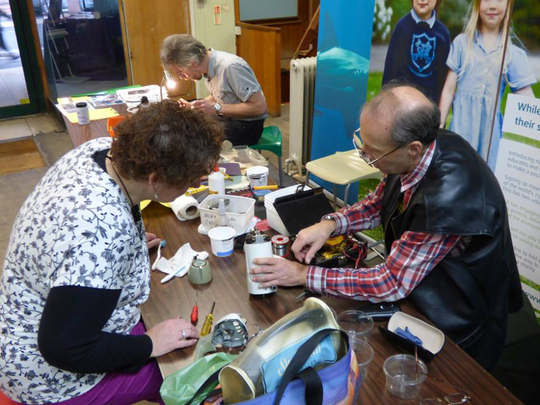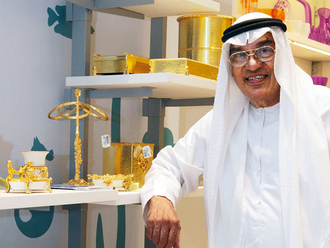
Dubai
If an item breaks at home, what do you do? Would you try to repair it or just replace it with something new?
Gulf News posed these questions to its readers, and though most of them did want to repair an object, the high cost of doing so discouraged them.
Meena Shivnani, an Indian banker based in Dubai, has noticed that sometimes buying a new item costs around the same.
She said: “If the repair cost is high, it doesn’t make sense. For example, the cost to repair household items like irons, microwaves and other electronics is high. So, in such cases, replacing them with new products is more feasible. Additionally, getting anything repaired here requires you to find a designated shop. They should be easily accessible.”
There have been many instances where she has taken the initiative and gotten an object repaired instead of throwing it away. However, she would only consider it if it didn’t mean letting go of a new product that had a similar price.
Eva Singh, an Indian national based in Dubai, agrees. While she is for the concept of repairing, because it means lesser trash ends up in the landfills, the price throws her off.
She said: “I had a sofa that needed to be repaired. I went to a store in Al Karama, Dubai. After hearing the prices, I thought it would be better to buy a new sofa. It was a beautiful piece of furniture, which I had to throw away with a heavy heart.”
Anjum Ahmad, a Pakistani teacher based in Sharjah, finds it inconvenient to look for a store and instead hopes that a broken object could be dropped off at any of the respective brand’s outlets. However, in her experience, she has had to find specific repair centres, which makes it harder.
She said: “Apart from the cost factor, I may not have enough time, or just be lazy to get things repaired. It depends on how easily something can be replaced, whether it has a substitute, or how frequently I need to use the item. Cost of repairing can sometimes be very high depending on the brand, thus I prefer to get something replaced, as the time and effort put in getting something repaired may not be worth it.”
According to the World Bank, the global solid waste generation was 3.5 million tonnes per day in 2010. This number is expected to rise to 6 million tonnes per day by 2025. By 2100, the world’s population will be producing three times as much waste as it does today.
To help solve this issue, a global Amsterdam-based network is slowly on the rise. The Repair Café International Foundation is spreading its wings, allowing people to repair broken objects at their venues for free, instead of replacing them with new ones.
Judy Sijlbing, an employee of the Repair Café International Foundation and a Repair Café organiser, told Gulf News through email: “Most Repair Cafés are opened once a month, during a part of the day, in a public venue. Everyone can walk in freely with broken stuff, like appliances, video and sound equipment, printers, electric or mechanical tools, toys, small furniture, clothes and bikes.”
The visitors are then helped by volunteers, who repair the broken items, while teaching the visitors how to repair them. These people are technically skilled and are referred to as the ‘repairders’ by the organisation. Some of them are technical professionals, while others are just those for whom repairing is a hobby.
The repair is done free of cost, but the visitors can leave tips if they wish to. Additionally, the foundation asks for donations, which cover the room rent, refreshments and allows them to purchase repair equipment. As they wait, the visitors can also enjoy a cup of coffee and socialise.
The foundation works on the principles that repairing is better than throwing or recycling and beneficial for the planet.
Sijlbing said: “In principle, everything you can transport easily to the Repair Café can be repaired. Some electronic devices, like smartphones and LED televisions, are difficult to repair. The special expertise, which is required to repair these type of items, is not always available.
“As far as smartphones are concerned, it is known that some brands are difficult to repair, because the devices can hardly be opened, or they require special tools, or new parts are hard to get.”
According to Sijlbing, most of the time, the visitors leave happy as their objects get repaired, especially those who place a special value on the item that had broken.
She said: “You cannot replace things like that by new items. But, people are even glad when their vacuum cleaner is ready to use again. By visiting the Repair Café they usually save money that they would spend on a new item.”
In its 2016 annual report, the foundation estimated that Repair Cafés prevented 250,000kg of waste from reaching the landfills. Sijlbing works at the Repair Café in Utrecht, The Netherlands and stated that it is approached by at least 25 visitors every time they are open. This specific cafe is open for just 2.5 hours one Saturday in a month. So, that is 300 visitors in a year. Globally, there are 1,500 cafes currently, in 35 countries.
Martine Postma, Director of the Repair Café International Foundation, believes that more countries should adopt this concept in order to increase the current statistics of trash saved from landfills.
She said: “We believe that people around the world can benefit from Repair Cafés, both as a location to have broken items repaired and learn about repairing. The more Repair Cafés there are, the better. The foundation helps volunteers around the world to start Repair Cafés in their own community. We would love the concept to spread more in Asian countries.”
More information, about this concept can be found at https://repaircafe.org.
Omar Khammash, a Jordanian training manager based in Dubai, thinks this concept should be implemented in the UAE, too.
He said: “It is a great idea! I always try to fix a broken item first and if I can’t, I usually will send it to the service centre. If it was a low cost item, then I might simply throw it away. But, definitely not a smartphone. I would be good with a free repair service.”








